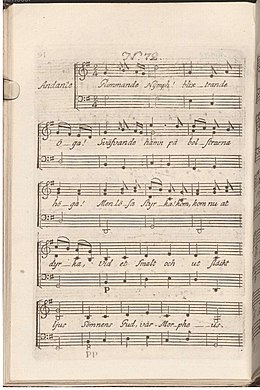Glimmande nymf
| "Glimmande Nymf" | |
|---|---|
| Art song | |
 First page of sheet music for the 1810 edition | |
| English | Gleaming Nymph |
| Written | 1771, revised 1790 |
| Text | poem by Carl Michael Bellman |
| Language | Swedish |
| Melody | from Le peintre amoureux de son modèle |
| Composed | 1757 |
| Published | 1790 in Fredman's Epistles |
| Scoring | voice and cittern |
Glimmande Nymf! blixtrande öga! (Gleaming Nymph, flashing eye!), is a song by the Swedish poet and performer
Bellman's biographer, Paul Britten Austin, calls the song exquisitely delicate. It is innocently worded but clearly erotic; the initial version culminated in an account of orgasm. The mood is conveyed with a description of a rainbow — after sunset, abandoning realism for poetic effect. The melody has been called "languorous and intense".[1]
Context
Song
Music and verse form
The music is in
Lyrics
Although first published in 1790 with the other epistles, Glimmande nymf came to Bellman in 1771, in one of his first attempts at songwriting. The initial version was direct in its description, telling the nymph to "Lay on this chair your robe, trousers, cardigan and skirt". It culminated in an account of the "little death" (
| Carl Michael Bellman, 1790[2][16] | Eva Toller's prose, 2004[17] | Paul Britten Austin's verse, 1967[18] |
|---|---|---|
| Glimmande Nymph! blixtrande öga! Sväfvande Hamn på bolstrarna höga! Menlösa styrka! Kom, kom nu at dyrka, Vid et smalt och utsläckt ljus, Sömnens Gud, vår Morpheus. Luckan ren stängd, Porten tilsluten, Natthufvan ren din hjässa kringknuten, Ren Norströms pisk-peruk den hänger på sin spik. |: Sof, somna in vid min Musik. :| |
Glittering nymph, (with) flashing eyes, soaring apparation on the high feather-bed, benevolent strength, come, come now to worship by a thin and extinguished candle the god of sleep, our Morpheus! The shutter is already closed, the gate is locked, the nightcap is fastened 'round the crown of your head; already Norström's wig hangs on its hook. |: Sleep, fall asleep to my music! :| |
Glimmering nymph, glances so sparkling Hovering wraith on pillows darkling, Innocent temptress Come, come now to vespers; By a candle's waxy heap, Morpheus worship, god of sleep Lock'd is the door, the shutter in place is; Drowsy thy head a nightcap embraces; Now Norström's old peruque Its rusty nail doth seek. |: Slumber, sweet nymph, to my musique! :| |
Reception

Britten Austin describes the song as "A lovely night-piece, its exquisite delicacy is best appreciated when considered against the background of its hushed and fragile music."
The scholar of literature
Bellman's biographer, Carina Burman, writes that the song's lyrical depiction of the delights of sexual intercourse is one of the real jewels of Swedish literature, but that the summer 1771 draft differs markedly from the final version. The first verse invited the nymph to lay her clothes on a chair and fall asleep to "my violin", which Burman describes as phallic, rather than noting prosaically that Norström's wig was hanging on its hook, and inviting Norström's wife to go to sleep to "my music". The second verse, too, is much toned down in the familiar final version. The verse ended not with the account of the rainbow, but with an exhortation to the nymph to open her bed and to hear "my violin, strong as a bassoon". Burman comments that the violin comes out again, strong and erect.[19]
Epistle 72 has been recorded by Fred Åkerström as the title track on his album called Glimmande nymf, and by Cornelis Vreeswijk.[20]
References
- ^ a b c d e f g h i Lönnroth 2005, pp. 309–314.
- ^ a b Bellman 1790.
- ^ Bellman Society. Archived from the originalon 10 August 2015. Retrieved 25 April 2015.
- ^ "Bellman in Mariefred". The Royal Palaces [of Sweden]. Archived from the original on 21 June 2022. Retrieved 19 September 2022.
- ISBN 978-0131369207.
- ^ Britten Austin 1967, pp. 60–61.
- ^ Britten Austin 1967, p. 39.
- ^ Britten Austin 1967, pp. 81–83, 108.
- ^ Britten Austin 1967, pp. 71–72 "In a tissue of dramatic antitheses—furious realism and graceful elegance, details of low-life and mythological embellishments, emotional immediacy and ironic detachment, humour and melancholy—the poet presents what might be called a fragmentary chronicle of the seedy fringe of Stockholm life in the 'sixties.".
- ^ Britten Austin 1967, p. 63.
- ^ Hassler & Dahl 1989, p. 170.
- ^ "Fredmans Epistel N:o 72". Bellman.net. Retrieved 17 March 2016.
- ^ Massengale 1979, p. 200.
- ^ Stenström, Johan (22 March 2005). "Ljuva karneval! Om Carl Michael Bellmans diktning Bellman bakom maskerna". Svenska Dagbladet. Retrieved 9 March 2016.
- ^ Britten Austin 1967, p. 132.
- ^ Hassler & Dahl 1989, pp. 169–172.
- ^ Toller, Eva (2004). "Glittering Nymph - Epistle No. 72". Eva Toller. Retrieved 13 June 2021.
- ^ a b c Britten Austin 1967, pp. 87–88
- ^ Burman 2019, pp. 477–480.
- ^ Hassler & Dahl 1989, p. 284.
Sources
- Bellman, Carl Michael (1790). Fredmans epistlar. Stockholm: By Royal Privilege.
- ISBN 978-3-932759-00-0.
- ISBN 978-9100141790.
- Hassler, Göran; ISBN 91-7448-742-6. (contains the most popular epistles and songs, in Swedish, with sheet music)
- ISBN 91-7736-059-1. (with facsimiles of sheet music from first editions in 1790, 1791)
- OCLC 61881374.
- ISBN 91-554-0849-4.


